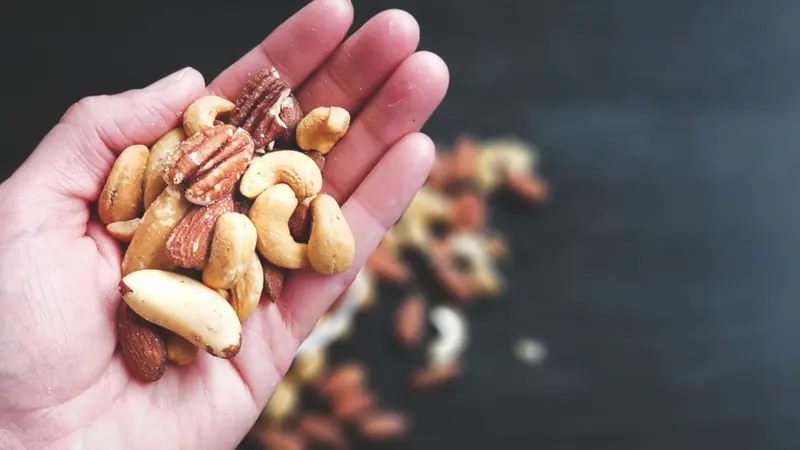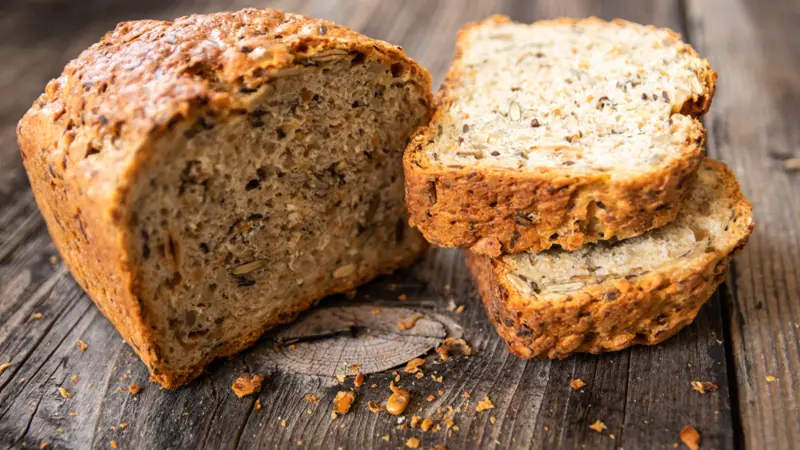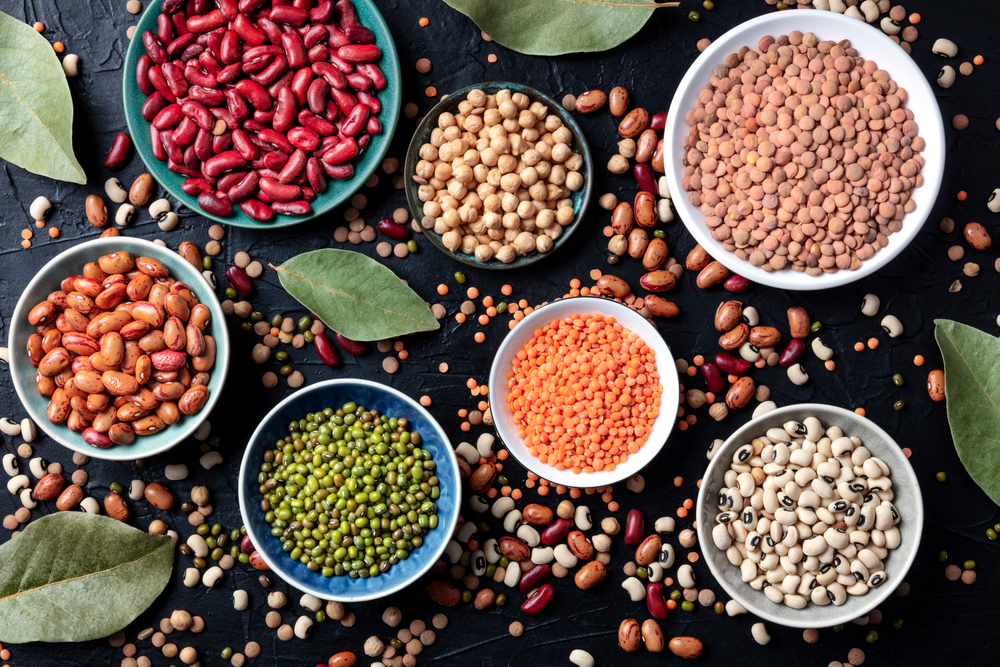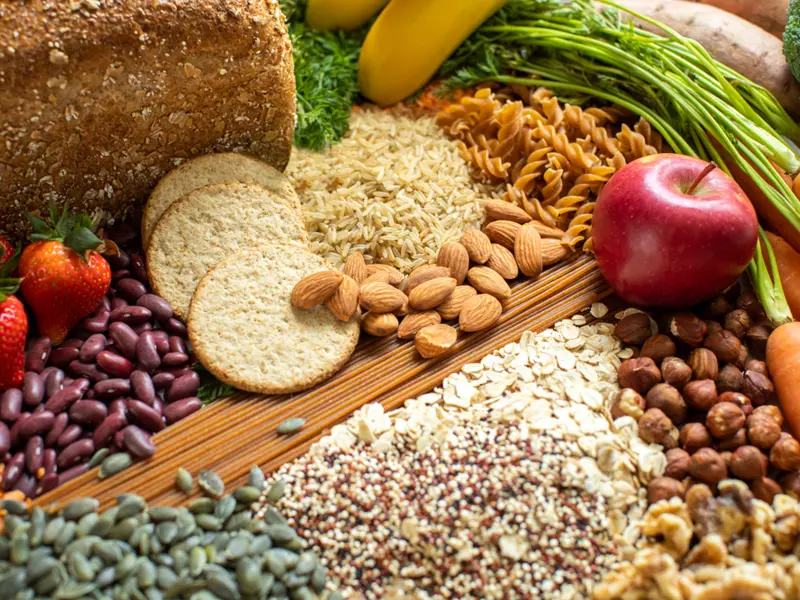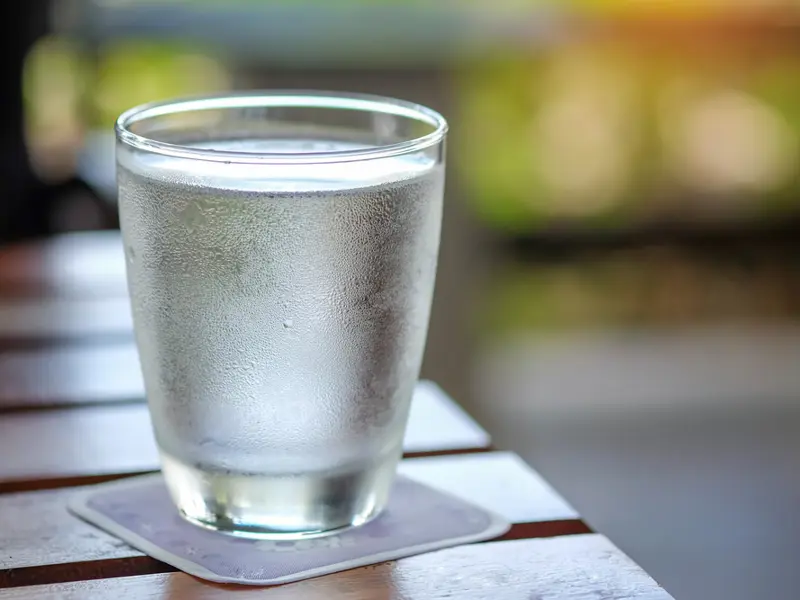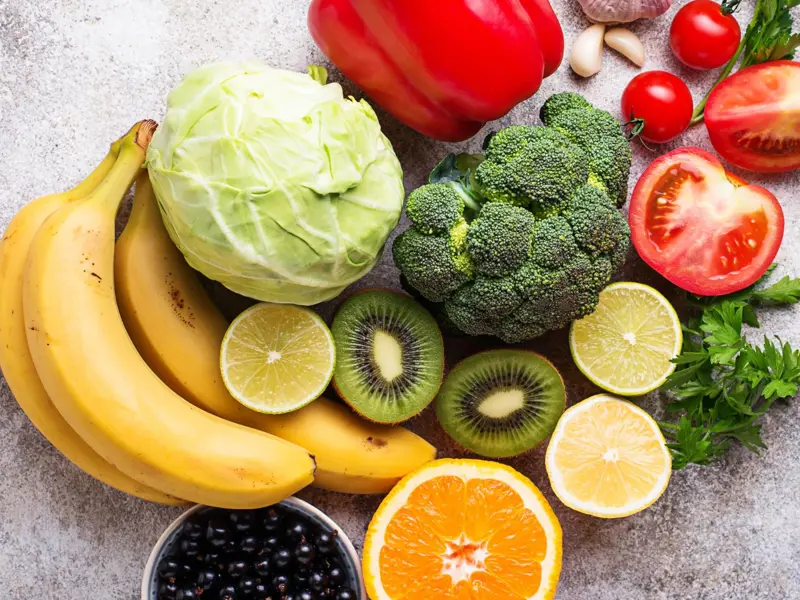What is dietary fibre?
Dietary fibre refers to a complex group of substances in plant foods which cannot be completely broken down by human digestive enzymes. This includes waxes, lignin, beta-glucans and polysaccharides such as cellulose and pectin.
Originally, it was thought that dietary fibre was completely indigestible and did not provide any energy. It is now known that some types of fibre can be fermented in the large intestine by gut bacteria (collectively known as the gut microbiota), producing short-chain fatty acids and gases (methane, hydrogen and carbon dioxide). The fatty acids are absorbed into the bloodstream and provide a small amount of energy which can be used by the cells lining in the colon - this is thought to strengthen gut barrier function.
The European Commission (EC), in line with the international CODEX Alimentarius Commission, agreed upon a definition for fibre in 2009. Below is the definition of fibre on the provision of food information to consumers and falls under Regulation (EU) No. 1169/2011:
Definition of dietary fibre:
Carbohydrate polymers with three or more monomeric units (to exclude mono- and disaccharides, simple sugars of one or two molecules), which are neither digested or absorbed in the small intestine and belong to one or more the following categories:
- Edible carbohydrate polymers naturally occur in the food as consumed.
- Carbohydrate polymers that have been obtained from food raw material by physical, enzymatic or chemical means and which have a beneficial physiological effect demonstrated by generally accepted scientific evidence.
- Synthetic carbohydrate polymers which have a beneficial physiological effect demonstrated by generally accepted scientific evidence.
Except for non-digestible edible carbohydrate polymers that occur naturally in foods, the definition states that there should be evidence of a beneficial physiological effect of any other material captured by the definition. Any beneficial physiological effect of other material needs to be supported by generally accepted scientific evidence.
|
Different kinds of fibre
While the terms ‘soluble’ and ‘insoluble’ fibre are still used today, they are not considered to be scientifically accurate as some types of fibre vary in their solubility depending on their source and level of processing.
Fermentability is considered a more relevant way to categorise fibres, in terms of how they affect health, and fibres may be classified as more or less fermentable. Fibres can also be described in terms of their viscosity. Viscous fibres (mostly soluble fibres) thicken when mixed with fluids and include gums, pectins, psyllium, and beta-glucans. They form a gel-like substance in the gut which can slow the rate of absorption of nutrients such as glucose.
Table 1 below shows some examples of the variability in the characteristics of different types of fibre in terms of the solubility, viscosity and fermentability.
|
Fibre type
|
Common sources
|
Physiochemical characteristics
|
|
Solubility
|
Viscosity
|
Fermentability
|
|
Cellulose
|
All green plant cell walls
|
Insoluble
|
Non-viscous
|
Low
|
|
Arabinoxylans
|
Wheat, psyllium
|
Low-medium
|
Medium
|
High
|
|
Beta-glucans
|
Oats, barley, fungi
|
Low-medium
|
Medium-high
|
High
|
|
Pectins
|
Fruit, vegetables, legumes
|
High
|
Medium-high
|
High
|
|
Inulin
|
Cereals, fruits vegetables
|
Medium-high
|
Low-high
|
High
|
|
Galacto-oligo saccharides
|
Pulses
|
High
|
Low
|
High
|
|
Resistant starch (type RS3)
|
Cooked and cooled starchy foods
|
Low
|
Non-viscous to low
|
High
|
The evidence for the links between dietary fibre and health was reviewed in 2015 by the Scientific Advisory Committee on Nutrition (SACN), which found that there is strong evidence that diets rich in fibre, particularly cereal fibre and wholegrains, are associated with a lower risk of many health conditions, including cardiovascular disease, coronary events, stroke, type 2 diabetes and colorectal cancer.
The nutritional benefits of fibre
There is evidence to suggest that diets high in dietary fibre are associated with a number of health benefits including: improved digestive and heart health, a reduction in the risk of some diseases, a role in weight management and supporting a more favourable balance of bacteria in the gut.
Fibre and digestive health
Sources of less fermentable fibre can act as bulking (laxative) agents and help prevent constipation. For fibre to have the best effect on preventing constipation, an increase in fibre intake should be accompanied by an increase in fluid intake. Some oligosaccharides (a type of fibre with a shorter carbon chain length) can be fermented by gut bacteria and may have a beneficial effect on the gut microbiota.
Fibre and heart health
Some fermentable fibres eaten in large amounts can help reduce blood cholesterol levels. Diets rich in fermentable fibre, such as fruits and grains, and in particular, oats, have been shown to reduce low density lipoprotein (LDL)-cholesterol.
Fibre and type 2 diabetes
Dietary fibre has been shown to improve glycaemic control and has an important role in managing diabetes. Studies suggest that a high intake of dietary fibre reduces the risk of developing type 2 diabetes. There is also evidence specifically for higher intakes of cereal fibre and higher wholegrain consumption and lower incidence of type 2 diabetes.
Fibre, energy balance and body weight
The SACN carbohydrates report concluded that there was no evidence from randomised trials to show that dietary fibre intake influences body weight changes or energy intake. They said that there was limited evidence from trials that a higher intake of wholegrains may decrease total dietary energy intake, but that more evidence is needed to confirm this. A systematic review published in 2020 did not find evidence that wholegrains had an effect on body weight.
Studies looking at the effect of fibres and fibre-rich foods on appetite, energy intake and body weight have had inconsistent results. However, a systematic review and meta-analysis of randomised controlled trials published in 2020 found that intake of viscous fibres such as beta-glucan, psyllium or guar gum can result in modest reductions in body weight, BMI and waist circumference. It was suggested that viscous fibres could affect energy intake as they increase the viscosity of the gut contents, promote gastric distention and slow gastric emptying as well as potential effects on satiety hormones.
Fibre and the gut microbiome
There has been growing interest in the potential impact of the bacteria in our gut on health and disease, and how our diet could modulate this.
The human gut microbiota (the community of microorganisms in the gut) is estimated to number approximately 100 trillion organisms – mainly bacteria but also viruses, fungi and other micro-organisms. The gut microbiota has important roles in immunity, digesting food, gut hormone and neurological signalling, the metabolism of drugs and elimination of toxins.
The gut microbiota develop from birth and early childhood then tend to remain relatively stable from later childhood into adulthood. The balance of different bacterial species in the gut varies between individuals and can be affected by factors including mode of birth (vaginal or caesarean section), infant feeding, lifestyle, medications, and genetics. There is currently no agreed definition of exactly what makes a ‘healthy’ gut microbiota but having a greater diversity of species is associated with positive effects and certain bacterial strains produce compounds that are associated with health benefits.
A plant-rich diet can provide fermentable fibres such as inulins and galacto-oligosaccharides which are ‘pre-biotic’, that is, they provide food for beneficial bacteria species such as Bifidobacterium and Lactobacillus, selectively increasing their numbers in the gut. When such species ferment fibres, they produce the short-chain fatty acids acetate, butyrate and propionate. These compounds provide an energy source for the cells in the gut as well as having potential roles in modulating hormones such as peptide YY (PYY) and glucagon-like peptide 1 (GLP-1), that are involved in appetite control and glucose metabolism.
Studies in animals and in humans have shown differences in gut microbiota between healthy individuals and those affected by a range of conditions including obesity, type 2 diabetes, eczema, inflammatory bowel disease and arterial stiffness. A lack of diversity, lower levels of beneficial bacteria and higher levels of harmful bacteria seem to be common features of the gut microbiota in disease states. The relationship between the gut microbiota and obesity has generated particular interest as studies have found that faecal transplants from obese or lean humans into germ-free mice can cause or prevent obesity respectively. However, much of the work in this area has been in mouse models, and we need more research in humans to better understand how the gut microbiota may be linked with body weight.
The relationship between the gut microbiota, diet and health is a complex and emerging field. What does seem clear is that a healthy dietary pattern that is rich in a variety of plant foods is likely to support a more favourable balance of bacteria in the gut, alongside the other beneficial effects that we know are associated with this type of diet. A ‘healthy’ gut microbiota may have several health benefits in terms of maintaining a healthy gut and reducing risk of disease.
Implications of a diet lacking fibre
A low fibre diet in humans has been linked to obesity, constipation and other gut issues such as bloating and gas. As outlined above, high fibre diets are associated with the prevention of some diseases, therefore a diet lacking in fibre may increase the risk of various diseases.
Eating a diet low in fibre is associated with diverticulitis (where the bowel wall becomes inflamed and ultimately damaged) and colorectal cancer. Evidence suggests a protective effect of eating a diet rich in dietary fibre on diverticulitis (particularly fruit and cereal fibre) and colorectal cancer.
Fermentation of prebiotic fibres (discussed above) promotes the protective layer of mucus on the gut wall, providing a barrier function that is important for maintaining a healthy gut. Conversely, diets high in animal fats and protein and low in fibre may promote ‘dysbiosis’, an imbalance of bacteria in the gut, resulting in lower production of short-chain fatty acids, a leaky gut mucosa and intestinal and systemic inflammation.
Research Snapshot: The evidence on fibre and health
The 2015 SACN report on Carbohydrates and Health reviewed the wealth of available evidence for the links between fibre and health outcomes. SACN concluded that there is strong evidence from prospective cohort studies that diets rich in fibre, particularly cereal fibre and wholegrains, are associated with a lower risk of cardiovascular disease, coronary events, stroke, type 2 diabetes and colorectal cancer. The randomised controlled trials included in the report did not show an effect of dietary fibre intake on type 2 diabetes or cardiovascular risk factors such as fasting blood lipids, glucose or insulin, but did support the role of fibre in bowel function (decreased intestinal transit times and increased faecal mass). Find out more about the report from SACN's website. |
Fibre-containing foods
Because the components of dietary fibre are found in different proportions in fibre-containing foods and have different properties, it is important to eat a variety of fibre-containing foods.
Some examples of different components of fibre and their food sources are listed below:
Table 2: Fibre and their food sources
|
Fibre component
|
Description
|
Food sources
|
|
Cellulose
|
Polysaccharides comprising up to 10 000 closely packed glucose units arranged linearly.
|
Grains, vegetables, fruit, nuts, cereal bran.
|
|
Hemicellulose
|
Polysaccharides containing sugars other than glucose.
|
Cereal grains, vegetables, fruit, legumes (like peas, beans, chickpeas, lentils) and nuts.
|
|
Lignin
|
A non-carbohydrate component associated with plant walls.
|
Foods with a woody component, for example celery and the outer layers of cereal grains.
|
|
Beta-glucans
|
Glucose polymers that (unlike cellulose) have a branched structure
|
Mainly found in cell wall of oats and barley.
|
|
Pectins
|
A non-starch polysaccharide common to all cell walls.
|
Fruits and vegetables, legumes, nuts and potatoes.
|
|
Gums and mucilages
|
Non-starch polysaccharides which are thick gel-forming fibres that help hold plant cell walls together.
|
Gums: seeds and seaweed extracts; Mucilages: pysillium seeds. Gums and mucilages are used as gelling agents, thickeners, stabilisers and emulsifying agents.
|
|
Resistant starch
|
Starch and the products of starch digestion that are not absorbed by the small intestine.
|
Legumes, potatoes, cereal grains.
|
|
Oligosaccharides
|
Short chain carbohydrates of 3-9 monomers. These include fructo-oligosaccharides and galacto-oligosaccharides.
|
Onions, chicory, Jerusalem artichokes.
|
|
Micro components (waxes, cutin and suberin)
|
Micro components of the plant structures.
|
Cereal grains.
|
Fibre claims on food labels
Nutrition information on food labels must comply with a format set out within the EU Food Information for Consumers Regulations. Whilst it is mandatory to state the energy, fat, saturates, carbohydrates, sugars, protein and salt content of a food, the provision of fibre content is voluntary.
Similarly to carbohydrates, fats and proteins, fibre is a source of energy providing an average of 2kcal per gram. Manufacturers may voluntarily claim foods as a ‘source of fibre’ if it contains at least 3g of fibre per 100g or at least 1.5g of fibre per 100kcal, or ‘high in fibre’ if it contains at least 6g of fibre per 100g or at least 3g of fibre per 100kcal. Where these claims are used, the fibre content must be provided in the nutrition information.
No health claims have been approved for ‘dietary fibre’ as a claim must be based on robust evidence for a specific cause and effect relationship, which is not possible for the diverse category of compounds included in the fibre definition.
A range of health claims relating to specific fibre types have been authorised for use in Great Britain (England, Wales and Scotland), which describe the relationship between consumption of the fibre type and health. There are conditions of use associated with each claim that must be met for a product to carry a claim, including in some cases specific information that must be provided to the consumer where a claim is made. Some examples of authorised claims are given below.
A full list of authorised claims can be found in the Great Britain nutrition and health claims (NHC) register.
Table 3: Examples of authorised nutritional fibre claims and conditions
|
Fibre type
|
Claim
|
Conditions of use
|
|
Barley grain fibre
|
Barley grain fibre contributes to an increase in faecal bulk
|
The claim may be used only for food which is high in fibre as referred to in the claim HIGH FIBRE* as listed in the Annex to Regulation (EC) No 1924/2006.
|
|
Beta-glucans
|
Beta-glucans contribute to the maintenance of normal blood cholesterol levels
|
The claim may be used only for food which contains at least 1g of beta-glucans from oats, oat bran, barley, barley bran, or from mixtures of these sources per quantified portion. In order to bear the claim, information shall be given to the consumer that the beneficial effect is obtained with a daily intake of 3g of beta-glucans from oats, oat bran, barley, barley bran, or from mixtures of these beta-glucans.
|
|
Beta-glucans from oats and barley
|
Consumption of beta-glucans from oats or barley as part of a meal contributes to the reduction of the blood glucose rise after that meal
|
The claim may be used only for food which contains at least 4g of beta-glucans from oats or barley for each 30g of available carbohydrates in a quantified portion as part of the meal. In order to bear the claim, information shall be given to the consumer that the beneficial effect is obtained by consuming the beta-glucans from oats or barley as part of the meal.
|
|
Oat grain fibre
|
Oat grain fibre contributes to an increase in faecal bulk
|
The claim may be used only for food which is high in that fibre as referred to in the claim HIGH FIBRE* as listed in the Annex to Regulation (EC) No 1924/2006.
|
|
Oat beta-glucan
|
Oat beta-glucan has been shown to lower/reduce blood cholesterol. High cholesterol is a risk factor in the development of coronary heart disease
|
Information shall be given to the consumer that the beneficial effect is obtained with a daily intake of 3g of oat beta-glucan.
The claim can be used for foods which provide at least 1g of oat beta glucan per quantified portion.
|
|
Resistant starch
|
Replacing digestible starches with resistant starch in a meal contributes to a reduction in the blood glucose rise after that meal.
|
The claim may be used only for food in which digestible starch has been replaced by resistant starch so that the final content of resistant starch is at least 14% of total starch.
|
|
Rye fibre
|
Rye fibre contributes to normal bowel function
|
The claim may be used only for food which is high in that fibre as referred to in the claim HIGH FIBRE* as listed in the Annex to Regulation (EC) No 1924/2006.
|
|
Wheat bran fibre
|
Wheat bran fibre contributes to an acceleration of intestinal transit
|
The claim may be used only for food which is high in that fibre as referred to in the claim HIGH FIBRE* as listed in the Annex to Regulation (EC) No 1924/2006. In order to bear the claim, information shall be given to the consumer that the claimed effect is obtained with a daily intake of at least 10g of wheat bran fibre.
|
|
Wheat bran fibre
|
Wheat bran fibre contributes to an increase in faecal bulk
|
The claim may be used only for food which is high in that fibre as referred to in the claim HIGH FIBRE* as listed in the Annex to Regulation (EC) No 1924/2006.
|
*Foods must contain at least 6g of fibre per 100g or at least 3g of fibre per 100kcal to qualify as ‘high in’ fibre
Fibre dietary requirements
When SACN assessed evidence for the links between fibre and health outcomes, it found a significant reduction in risk of cardiovascular disease, type 2 diabetes and colorectal cancer at 30g fibre or more per day. This is consistent with authoritative bodies around the world, who typically recommend dietary fibre intake of 25-30g per day for adults. SACN therefore recommends 30g/day as a revised adult intake for adults in the UK.
UK adults are not getting enough fibre. The average intake of UK adults is 20g fibre with the recommended daily intake at 30g. Socio-economic disparities exist with lower intakes in the lowest income quintile compared to the highest, in all age groups and in both sexes.
Dr Stacey Lockyer, Senior Nutrition Scientist, British Nutrition Foundation
The current recommendations for dietary fibre intake for both adults and children can be seen in the table below. These recommendations have been rounded to the nearest 5g and are informed by comparative intakes for dietary fibre in different age groups in the National Diet and Nutrition Survey.
Fibre-containing foods are very filling, especially for children under five, so the introduction of fibre should be done so gradually.
Table 4. Recommended dietary fibre intakes per age
|
Age group
|
Recommended dietary fibre intake
|
|
Adults
|
30g/day
|
|
Adolescents aged 16-18 years
|
30g/day
|
|
Children aged 11-16 years
|
25g/day
|
|
Children aged 5-11 years
|
20g/day
|
|
Children aged 2-5 years
|
15g/day
|
Total intakes and the main contributors of fibre in the UK diet for different age groups can be seen below.
Table 5. Total dietary fibre intakes for UK children and adults (National Diet and Nutrition Survey, years 9 to 11; 2016/2017 to 2018/2019)
|
|
Age group
|
|
|
1.5-3 years
|
4-10 years
|
11-18 years
|
19-64 years
|
65-74 years
|
75+ years
|
|
Total fibre intake (g/day)
|
10.4
|
14.3
|
16.0
|
19.7
|
19.7
|
17.3
|
|
Main contributors to intakes (%):
|
|
|
Cereals and cereal products
|
40
|
41
|
44
|
38
|
37
|
42
|
|
Vegetables and potatoes
|
22
|
26
|
25
|
30
|
32
|
27
|
|
Fruit
|
16
|
11
|
6
|
8
|
11
|
10
|
|
Meat and meat products
|
8
|
9
|
12
|
11
|
8
|
11
|
Dietary modelling
The British Nutrition Foundation carried out some simple dietary modelling to develop a 7-day menu plan which illustrates, in practice, what a diet that provides 30g of fibre and meets all other dietary recommendations looks like for adults.
It is possible to achieve the recommendation if meals are based on starchy foods (mostly wholegrain and high-fibre options), high-fibre snacks are selected and around eight portions of fruit and vegetables are consumed daily. However, this dietary pattern does not reflect most diets in the UK at present and would require people to make significant changes to the foods and drinks they consume.
For more in depth insights into fibre, explore the relevant training and events currently available from the British Nutrition Foundation.




